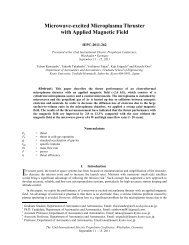Design Development and Test of the RIT-ÁX Mini Ion Engine System
Design Development and Test of the RIT-ÁX Mini Ion Engine System
Design Development and Test of the RIT-ÁX Mini Ion Engine System
You also want an ePaper? Increase the reach of your titles
YUMPU automatically turns print PDFs into web optimized ePapers that Google loves.
A <strong>RIT</strong>-µX ion engine requires propellant <strong>and</strong> electricity for operation. The propellant flow to <strong>the</strong> engine is<br />
controlled by a flow control unit (FCU), <strong>the</strong> required electric power is provided by <strong>the</strong> power processing unit (PPU).<br />
The PPU controls also <strong>the</strong> FCU.<br />
In contrast to <strong>the</strong> larger <strong>RIT</strong> engines like <strong>RIT</strong>-10 <strong>and</strong> <strong>RIT</strong>-22 it is possible to use gasless neutralizers, at least for<br />
low thrust (< 500 µN). Therefore no xenon flow management is required for <strong>the</strong> neutralizer. Fur<strong>the</strong>rmore it is not<br />
necessary to have one neutralizer dedicated to one thruster. It is important only that <strong>the</strong> total ion current expelled<br />
from all thrusters becomes completely compensated.<br />
<strong>RIT</strong>-µX <strong>Ion</strong> Thruster<br />
• Expels ions <strong>and</strong> produces thrust<br />
Neutralizer<br />
• Emits electrons to compensate ion current from<br />
thruster<br />
Radio Frequency Generator<br />
• Convert DC current into AC current (rf current)<br />
FCU<br />
• Regulate xenon flow to thruster<br />
Table 1 Components <strong>of</strong> a mini ion engine system<br />
PPU<br />
• Provides positive high voltage (defines beam<br />
potential <strong>and</strong> exhaust velocity)<br />
• Provide negative high voltage (optimizes ion<br />
extraction <strong>and</strong> prevents back streaming <strong>of</strong><br />
electrons into <strong>the</strong> thruster<br />
• Provide power for radio-frequency generator<br />
• Provide voltages for neutralizer<br />
• Measure <strong>and</strong> control beam current (thrust<br />
respectively) in close loop<br />
• Provide voltages for FCU<br />
• Control FCU<br />
• Exception h<strong>and</strong>ling etc.<br />
Please note: FCU, Neutralizer <strong>and</strong> PPU can serve multiple thrusters (cf. topologies). A detailed description exceeds<br />
<strong>the</strong> scope <strong>of</strong> this paper. For additional information refer to [2] [11] e.g.<br />
V. <strong>RIT</strong>-µX <strong>Test</strong>s <strong>and</strong> Results<br />
A. Overview<br />
In August, 2008 <strong>RIT</strong>-µX was subject to an extensive functional test campaign. Highlights <strong>of</strong> <strong>the</strong> test campaign<br />
were:<br />
• Performance characterization<br />
- Power consumption<br />
- Specific impulse<br />
- Thrust Range<br />
• Perveance measurements<br />
- Dynamic range <strong>of</strong> ion optics (grid system)<br />
• Electron back streaming test<br />
• Thrust dynamics<br />
- thrust stepping<br />
- thrust linearity<br />
• Thrust stability <strong>and</strong> noise measurement<br />
These tests were embedded in a typical test program with mass inspections, electrical checks <strong>and</strong> visual<br />
inspections. All tests were performed in <strong>the</strong> Bic-Mac <strong>Test</strong> facility <strong>of</strong> <strong>the</strong> first institute <strong>of</strong> physics in Gießen. Gießen<br />
University also provided <strong>the</strong> flow control system <strong>and</strong> all required electronics. The setup included a beam current<br />
controller developed by <strong>the</strong> institute.<br />
The ionizer <strong>and</strong> <strong>the</strong> carriers for <strong>the</strong> <strong>RIT</strong>-µX grid system are manufactured in alumina (ceramics). Manufacturing<br />
<strong>of</strong> <strong>the</strong>se parts is time consuming. To avoid additional delays in <strong>the</strong> schedule, <strong>the</strong>se parts have been additionally<br />
5<br />
The 31st International Electric Propulsion Conference, University <strong>of</strong> Michigan, USA<br />
September 20 – 24, 2009






